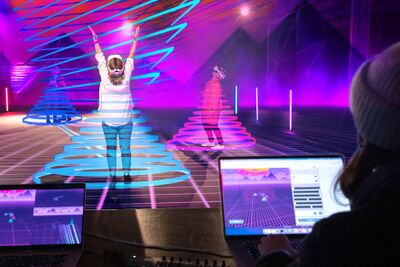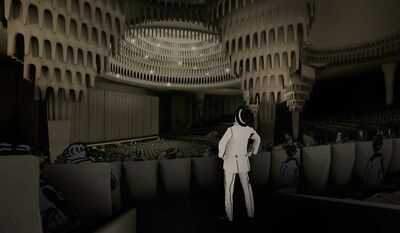With the rapid growth in the third decade of the 20th century of technologies for virtual (immersive) and augmented (hybrid) realities, theatre has available many new, virtual stages.
In Theater als Zwischenreich, Richard Alewyn wrote, ‘So this is the material the world of the stage is made of: a mixture of reality and appearance’ (1989). Theatre has always been a place for creating fantastic stories, a retreat, and a place of longing at the same time. As ‘world builders’, theatre-makers enable their audience to visit diverse places and travel through time to the future and the past. In theatre, different forms of narration are continually being re-explored and reinvented, in a constant interchange with new technologies, inventions and spatial arrangements. Accordingly, new technologies such as virtual and augmented reality (VR and AR, kinds of mixed reality) are not to be understood as ‘new’ technologies: theatre itself has a long tradition of being an immersive medium.
The medium of virtual reality – like theatre – holds great potential for experience through the interaction of different disciplines (film, literature, music, scenography, architecture, visual arts...). By putting on VR glasses, one steps out of ones immediate environment and shifts ones presence into a digital world, into a new reality. This complete dive into the virtual experience is called immersion. The gap that is created in most narrative formats by the viewing distance between the user and the experience is eliminated. Virtual reality enables a multitude of shifts in perspective, whether by embodying different characters or ‘roles’, or travelling to other times or to inaccessible places and situations. Physical laws and social conventions can be suspended: spaces can not only be entered but also flown through; leaps in scale become possible, the viewers themselves become actors.
Augmented Reality works differently: it is a mixing of reality and digital content, each enriching the other. The theatre has been familiar with this effect for a long time: in 1862, a ghost magically appeared on a stage and triggered a veritable illusion hype: the Pepper’s Ghost effect (B.05, Q305). The method of enriching the visible stage action with immaterial content is exactly what happens – figuratively speaking – when using augmented reality: the overlaying of reality with digital content. The potential of augmented reality lies in its fusion with our directly experienceable environment, so the city is also a stage.
Mixed Reality technologies open up completely new kinds for audience experience and artistic approaches. Digital theatre artists like the Cyberräuber with their dance experience Things Fall Apart or Raum+Zeit with their Brecht experience Berlau: Königreich der Geister explore the possibilities for Virtual Stages. AR installations such as Evelyn Hriberšek with EURYDIKE, or Nico and the Navigators with their Verrat der Bilder, show that those new realities have to be understood as an own artistic medium – and not as a substitute or supplement.
To explore the possibilities of these new realities, the research project Im/material Theatre Spaces by the German Theatre Association DTHG (Q19499) gives some useful examples. In the hybrid-real stage performance Spatial Encounters, developed by the digital.DTHG Team in 2021, explored the possibility of the audience co-creating the performance in a hybrid-real stage setting. In an open space of about 150 square metres, audience members (up to 9 VR users) were immersed in a virtual scene, which was then designed, made and experienced together for the next 20 minutes. They moved freely in these digital landscapes and generated visual effects and sculptures through their encounters and spatial relationships. The resulting immaterial spatial bodies and virtual sceneries were musically interpreted live. At the same time, the musicians themselves gave stimulating impulses and moods to the performative interplay. Through these diverse interactions, the shared experience in virtual space becomes a catalyst for a co-creative process of creation, at the intersection of analogue and digital worlds.
As well as being the medium through which an audience experiences a performance, virtual and augmented reality can also serve as tools for the production process. Theatres have experimented with virtual ‘Bauprobe’ (Q30656), in which stage designs can be developed and discussed virtually, or the future renovation process of a theatre building can be discussed online in a shared virtual space. Immersive technologies can also give access to im/material cultural heritage. With the virtual reconstruction of the Große Schauspielhaus, Berlin (Q9256), users can experience 3 different stories while ‘walking’ through the reconstructed building in 3D, and see historic theatre objects such as the cloud machine (Q30496) in action.
The arts have always been the impetus and source of inspiration for the development of new media technologies – and the arts, conversely, see new technologies as a space of possibility for the development of new forms of expression and design. Immersive and hybrid realities have become our new, virtual, stages.

